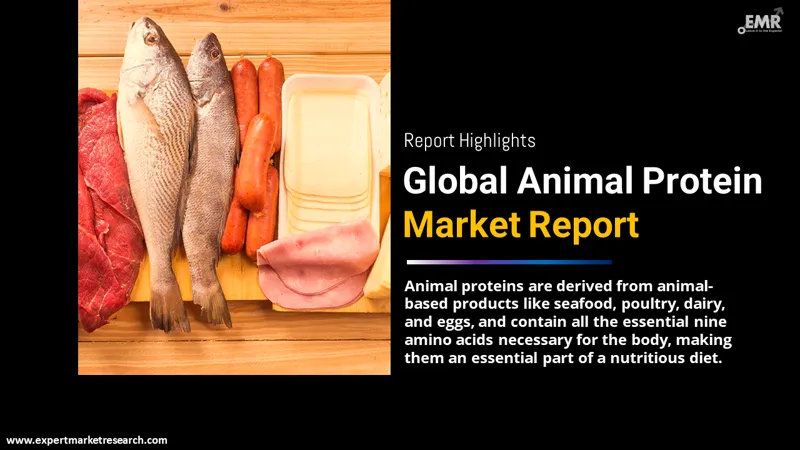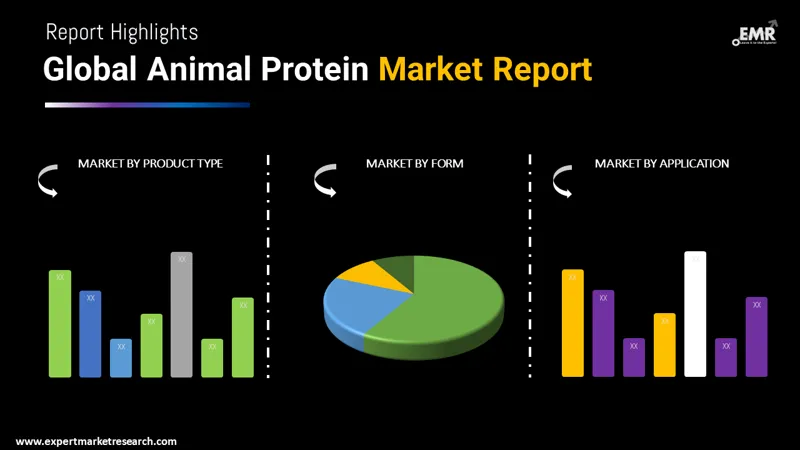
Consumer Insights
Uncover trends and behaviors shaping consumer choices today
Procurement Insights
Optimize your sourcing strategy with key market data
Industry Stats
Stay ahead with the latest trends and market analysis.
The global animal protein market is expected to grow at a CAGR of 4.10% between 2026 and 2035. Key market drivers include rise in demand for protein rich dietary supplements and growing demand from personal care industry.
Base Year
Historical Period
Forecast Period
Compound Annual Growth Rate
4.1%
2026-2035
*this image is indicative*
| Global Animal Protein Market Report Summary | Description | Value |
| Base Year | USD Million | 2025 |
| Historical Period | USD Million | 2019-2025 |
| Forecast Period | USD Million | 2026-2035 |
| Market Size 2025 | USD Million | XX |
| Market Size 2035 | USD Million | XX |
| CAGR 2019-2025 | Percentage | XX% |
| CAGR 2026-2035 | Percentage | 4.10% |
| CAGR 2026-2035 - Market by Region | Asia Pacific | 5.3% |
| CAGR 2026-2035 - Market by Country | India | 6.1% |
| CAGR 2026-2035 - Market by Country | China | 5.1% |
| CAGR 2026-2035 - Market by Product Type | Fish Protein | 4.6% |
| CAGR 2026-2035 - Market by Form | Liquid | 4.5% |
| Market Share by Country 2025 | Canada | 1.6% |
Proteins that are sourced from animal products are defined as animal proteins, and are commonly found in meats such as seafood and poultry, as well as in items such as diary and eggs. Animal proteins have the presence of all the important nine amino acids required by our body, making it an important component of a healthy diet. Animal proteins are known for lowering the risk of colorectal and heart diseases along with the risk of prostate, stomach, and pancreatic cancers.

Read more about this report - REQUEST FREE SAMPLE COPY IN PDF
“Animal Protein Market Report and Forecast 2026-2035” offers a detailed analysis of the market based on the following segments:
Market Breakup by Product Type
Market Breakup by Form
Market Breakup by Application
Market Breakup by Region

Read more about this report - REQUEST FREE SAMPLE COPY IN PDF
Both solid and liquid forms of proteins are widely consumed, however, liquid protein accounts for a larger share in the animal protein market. Liquid proteins are easy to consume anywhere and anytime, without need for specialised preparation or cooking. They are consumed in the form of shakes, shots, and gels.
Liquid proteins often contain less calories as compared to the solid animal protein form such as protein bars, making them suited for before or after workouts. Along with easy consumption they are also easily digestible. The growing popularity of protein shakes and social media promotion of various protein drinks is further encouraging the growth of the liquid segment of the market for animal proteins.
North America is expected to account for a leading segment in the animal protein market because of its established food supply chain. There is a strong presence of key market players in the region, with advanced technologies for processing and producing animal-based protein supplements and ingredients.
| CAGR 2026-2035 - Market by | Country |
| India | 6.1% |
| China | 5.1% |
| Saudi Arabia | 4.7% |
| Brazil | 4.5% |
| USA | 3.3% |
| Canada | XX% |
| UK | XX% |
| Germany | 3.0% |
| Italy | XX% |
| Japan | XX% |
| Australia | XX% |
| Mexico | XX% |
| France | 2.9% |
In North America, there is a substantial population of non-vegetarian consumers, with significantly high rates of meat consumption. With a widespread acceptance of animal-based products, there are significant opportunities for growth for animal proteins. Consumers are becoming aware of the advantages of animal proteins, increasing their demand and surging the market in the region.
The comprehensive EMR report provides an in-depth assessment of the market based on the Porter's five forces model along with giving a SWOT analysis. The report gives a detailed analysis of the following key players in the global animal protein market covering their competitive landscape and latest developments like mergers, acquisitions, investments, and expansion plans.
JBS S.A. is a food company that was established in 1953 and is headquartered in Sao Paolo, Brazil. A meat processing company, it is involved in the production and supply of factory processed pork, beef, and chicken, along with the by-products obtained from processing of meat.
Tyson Foods Inc. founded in 1935 is based out of Arkansas, United States. It is a food processing company that processes and markets beef, chicken, and pork. It is a leading exporter of beef outside the United States.
Darling Ingredients Inc. was founded in 1882 and has its headquarter in Texas, United States. It is an animal food manufacturing company which creates sustainable food products for use in animal feed, fertiliser, food, fuel, and bioenergy industries.
*Please note that this is only a partial list; the complete list of key players is available in the full report. Additionally, the list of key players can be customized to better suit your needs.*
Other market players include Cargill, Incorporated, Lactalis International, Arla Foods Amba, Nippon Suisan Kaisha, Ltd., Nestle S.A., Archer Daniels Midland Company, and GFPT Public Company Limited, among others.




*While we strive to always give you current and accurate information, the numbers depicted on the website are indicative and may differ from the actual numbers in the main report. At Expert Market Research, we aim to bring you the latest insights and trends in the market. Using our analyses and forecasts, stakeholders can understand the market dynamics, navigate challenges, and capitalize on opportunities to make data-driven strategic decisions.*
Get in touch with us for a customized solution tailored to your unique requirements and save upto 35%!
The market is expected to grow at a CAGR of 4.10% between 2026 and 2035.
Key market drivers include rise in demand for protein-rich dietary supplements, and growing in demand from the personal care industry.
The key trends of the market are increasing awareness regarding the benefits of animal proteins, rising availability, and wide varieties of animal proteins to cater to different preferences.
Key market players include JBS S.A., Tyson Foods Inc., Darling Ingredients Inc., Cargill, Incorporated, Lactalis International, Arla Foods Amba, Nippon Suisan Kaisha, Ltd., Nestle S.A., Archer Daniels Midland Company, and GFPT Public Company Limited, among others.
Proteins that are sourced from animals are defined as animal proteins which are usually found in meats such as seafood and poultry, as well as in dairy products and eggs.
Animal proteins contain all the important nine amino acids required by our body makes it an important component of a healthy diet.
The global animal protein market is segmented based on product type, form, application, and region.
Animal proteins are known for lowering the risk of colorectal and heart diseases along with the risk of prostate, stomach, and pancreatic cancers.
Explore our key highlights of the report and gain a concise overview of key findings, trends, and actionable insights that will empower your strategic decisions.
| REPORT FEATURES | DETAILS |
| Base Year | 2025 |
| Historical Period | 2019-2025 |
| Forecast Period | 2026-2035 |
| Scope of the Report |
Historical and Forecast Trends, Industry Drivers and Constraints, Historical and Forecast Market Analysis by Segment:
|
| Breakup by Product Type |
|
| Breakup by Form |
|
| Breakup by Application |
|
| Breakup by Region |
|
| Market Dynamics |
|
| Competitive Landscape |
|
| Companies Covered |
|
Single User License
One User
USD 3,999
USD 3,599
tax inclusive*
Datasheet
One User
USD 2,499
USD 2,249
tax inclusive*
Five User License
Five User
USD 4,999
USD 4,249
tax inclusive*
Corporate License
Unlimited Users
USD 5,999
USD 5,099
tax inclusive*
*Please note that the prices mentioned below are starting prices for each bundle type. Kindly contact our team for further details.*
Flash Bundle
Small Business Bundle
Growth Bundle
Enterprise Bundle
*Please note that the prices mentioned below are starting prices for each bundle type. Kindly contact our team for further details.*
Flash Bundle
Number of Reports: 3
20%
tax inclusive*
Small Business Bundle
Number of Reports: 5
25%
tax inclusive*
Growth Bundle
Number of Reports: 8
30%
tax inclusive*
Enterprise Bundle
Number of Reports: 10
35%
tax inclusive*
How To Order

Select License Type
Choose the right license for your needs and access rights.

Click on ‘Buy Now’
Add the report to your cart with one click and proceed to register.

Select Mode of Payment
Choose a payment option for a secure checkout. You will be redirected accordingly.
Gain insights to stay ahead and seize opportunities.

Get insights & trends for a competitive edge.

Track prices with detailed trend reports.

Analyse trade data for supply chain insights.

Leverage cost reports for smart savings

Enhance supply chain with partnerships.

Connect For More Information
Our expert team of analysts will offer full support and resolve any queries regarding the report, before and after the purchase.
Our expert team of analysts will offer full support and resolve any queries regarding the report, before and after the purchase.
We employ meticulous research methods, blending advanced analytics and expert insights to deliver accurate, actionable industry intelligence, staying ahead of competitors.
Our skilled analysts offer unparalleled competitive advantage with detailed insights on current and emerging markets, ensuring your strategic edge.
We offer an in-depth yet simplified presentation of industry insights and analysis to meet your specific requirements effectively.
Share